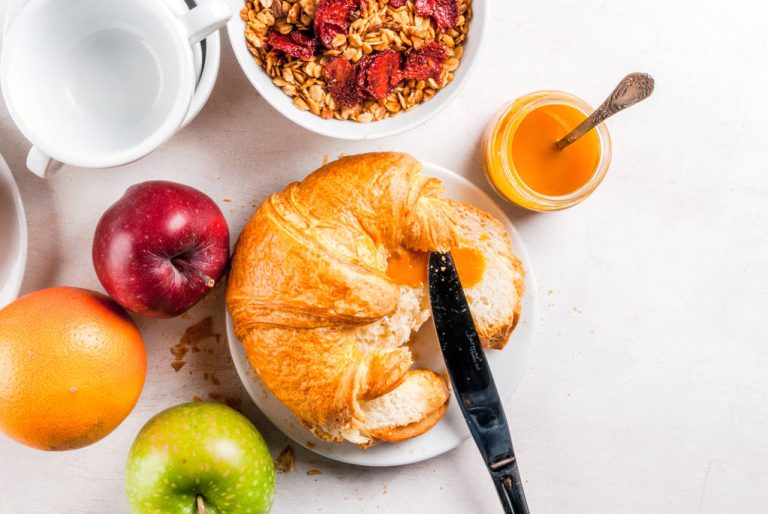Croissant, baguette, pain au chocolat, pain aux raisins… Obviously, for the French, breakfast is not just a meal, but a real pleasure that should best take place in a suggestive brasserie in Paris.
You can’t say that the French breakfast is very rich, hence the name “petit déjeuner” (in good German: small break of the fast), but sometimes less is more!
On weekdays, when everything has to be done quickly in the morning, the French usually only eat a croissant with honey and/or jam and drink large cups of café au lait (milk coffee) with it. At the weekend, on the other hand, the small, quick breakfast often turns into a larger brunch, where, in addition to the classic croissant, crepes, madeleines or hearty dishes are also served, such as baguettes with sausage and cheese, stuffed vegetables (petits farcis) or a piece of quiche Lorraine .
It’s not particularly sumptuous, especially compared to a hearty German breakfast, but the morning meal in France is a very tasty and enjoyable ritual that you should ideally take your time with.

The History of the French Croissant
The protagonist of the French breakfast is certainly the croissant: historically, its birth can be dated back to 1683, when the Turks besieged Vienna and dug an underground tunnel at night to enter the imperial city undisturbed. However, they had not counted on the Viennese bakers, who started their work before daybreak, heard the unusual noises of the tunnel builders and immediately alerted the soldiers.
As a thank you for saving the city from the Turks, Austrian bakers were now allowed to bake croissants in the shape of the Turkish crescent, which they called Kipferln. When the Empress Marie Antoniette married from the Viennese court to France in 1770, she introduced the croissant to Paris, where it was immediately called the croissant (translated: “rising moon”). In a short time, the croissant became the national specialty of France and still is today THE ambassador of savoir vivre.
How do you prepare a French breakfast?
Usually just having a croissant for breakfast during the week, French cuisine offers a wide selection of delicious baked goods that are served for a festive brunch at the weekend or on public holidays. So feel free to overdo it with the petit déjeneuer: combine baguettes, brioches and croissants with sweet strawberry or apricot jam and with French sausages and especially cheeses – Roquefort, Brie, Camembert… let your taste roam free!
Now let’s take a look at the ingredients you need to prepare a traditional French breakfast – in its more sumptuous version.

Ingredients (2 people)
2 croissants
4 madeleines
2 crepes (pancakes)
1 baguette (cut into small pieces)
Strawberry and/or apricot jam
honey
some butter
Sausage and cheese platter (some raw ham, salami, and French cheeses like Camembert, Brie, and Roquefort)
Stuffed vegetables (e.g. eggplant or zucchini)
2 pieces of quiche Lorraine
coffee or Ceylon tea
some milk (for the coffee)
8 oranges (for the juice)


